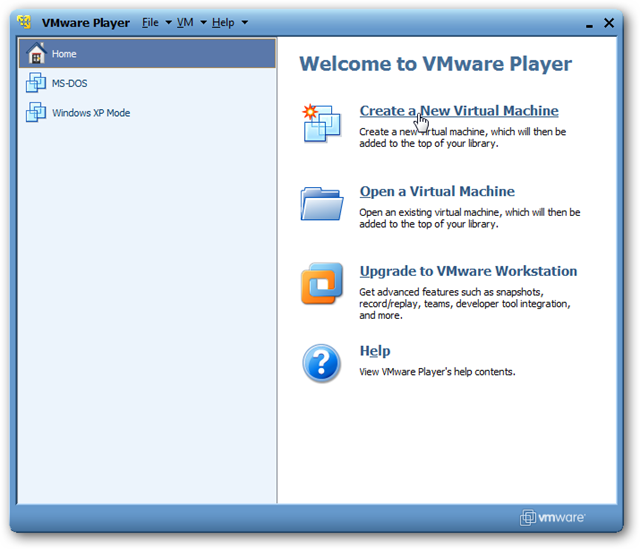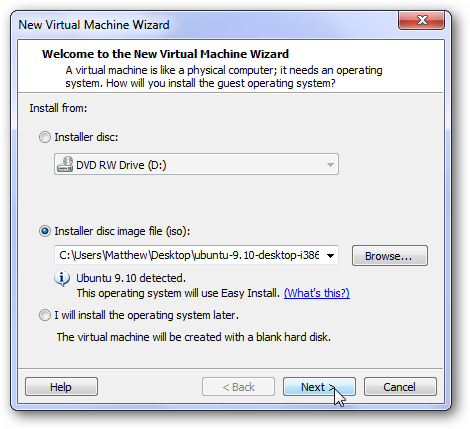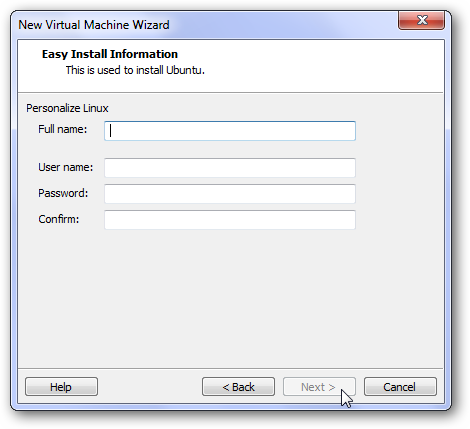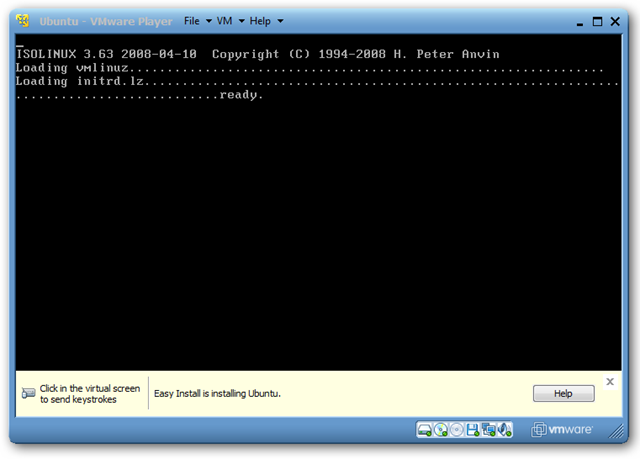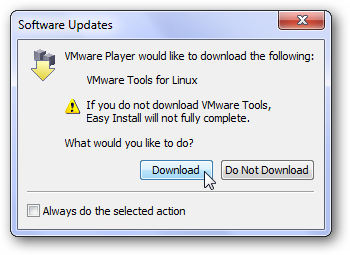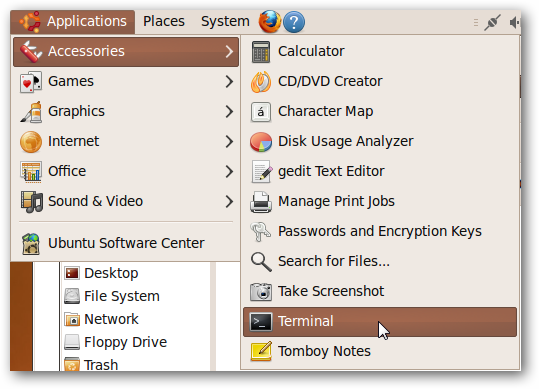Would you like to use Ubuntu Linux programs, but prefer the convenience of Windows 7? With VMware Player, you can install a full copy of Ubuntu and integrate it with your Windows 7 computer for free.
VMware Player makes it easy to install Ubuntu Linux as a virtual machine in only 5 clicks. It then offers easy access to Ubuntu programs straight from your desktop with Unity mode. Here’s how you can set this up on your computer.
Getting Started
First, download and install VMware Player (link below). It is a free download, but requires registration.
You may see some prompts about installing drivers; simply approve them. We didn’t see them on our latest test, but have in the past. When you are finished installing VMware Player, you will have to restart your computer.
Install Ubuntu
Once you have installed VMware Player and downloaded Ubuntu, you’re ready to setup Ubuntu. Open VMware Player, and choose “Create a New Virtual Machine.”
You can install Ubuntu from a disk, or directly from the ISO file you can download (link below). This is the simplest method if you’re simply wanting to use Ubuntu in VMware Player. However, if you do have an Ubuntu disk, then feel free to choose that instead. Once you’ve selected your install media, VMware Player will automatically detect Ubuntu and will show that it will be installed with Easy Install. Click next to continue.
Now enter your name, user name, and password. All fields are required.
Please note that the username can only have lowercase characters and numbers.
Also, the password must be at least 8 characters long.
Now, choose a name for your virtual machine and where to save it. Simply click next to accept the defaults.
You can choose how large you want your virtual hard drive to be; the default is 20Gb, but you can choose a different size if you wish. Please note that the entire 20Gb will not be used up on your hard drive initially. Ours only took up 3.6Gb with a clean install, but this will increase as you install programs and save files.
And that’s it! You can review your settings and change them here if you wish, or simply click Finish to start installing Ubuntu!
VMware player will now install Ubuntu without any further input. The window may show cryptic commands, but don’t worry, as you don’t have to do anything else to install Ubuntu.
During the install, you may be prompted to download and install VMware tools for Linux. Simply click Download and the tools will automatically download and install, though you may have to approve the UAC prompt.
VMware will continue installing Ubuntu even while the tools are downloading. Once the install is finished, you will be presented with your Ubuntu login screen. The full install took about 30 minutes in our test.
Select your user name, then enter your password to access Ubuntu.
Welcome to your Ubuntu desktop!
Installing VMware Tools
VMware Player will attempt to automatically install the VMware tools into Ubuntu during the initial setup, but sometimes this does not work. In our test, the tools failed to install during the Ubuntu setup since our internet connection was down. In your tests, it may or may not automatically install. If it doesn’t, follow the following steps to install them. Please note that this is fairly complicated, so be sure to enter the correct things during the install.
To install the tools, click VM and then select “Install VMware Tools” in the menu.
This will open a File Browser window. Double click on the VMwareTools icon; this should look like a box that says tar.gz on the front.
This will open the compressed file. Click the Extract button at the top of the window.
Now, choose where to save the files. Simply click “Desktop” on the left, and then click Extract.
This will take a moment. When the files are extracted, click “Close”.
Now, click the Applications menu at the top of the screen, click Accessories, and then click Terminal.
Enter the following to access the files you unzipped before:
cd ./Desktop/vmware-tools-distrib
Now, enter:
sudo bash
and enter your password when prompted. Please note that the password will not show while you are typing it in; simply type it in, and press Enter when completed.
Now we can install the VMware tools. To do this, enter:
./vmware-install.pl
and then simply press enter at the prompts to accept the defaults. It should ask a total of 5 questions, and just press enter at all of them.
After a bit, it may ask the following questions about documentation files; simply press enter again at each prompt.
The installation is now complete. You will still need to configure the tools, so simply enter “yes” at the prompt to automatically do that.
It may ask to enable an experimental backup feature; we simply entered “no” at this prompt.
Then, it will want to setup the graphics configurations. Enter “yes” at the prompt. Your screen may flicker or go black momentarily while it is changing these settings.
Finally, you will see the following message when the install is complete.
Restart Ubuntu by clicking on the button with your username at the top right, and then selecting Restart from the menu.
Once your virtual machine has rebooted, login to Ubuntu as before and your setup is complete!
Integrate Ubuntu with Windows 7
You can already use all of Ubuntu’s tools and features directly from the Ubuntu desktop in VMware Player. But, if you would like to use your Ubuntu programs seamlessly in Windows, we need to activate Unity mode. Click VM and then Unity Mode in the VMware Player Menu.
Now, you will have an Ubuntu menu right above your Windows 7 Start button!
By default, the Ubuntu windows will have a border and VMware logo on them.
To change this, click VM and then Settings, select the Options tab, and uncheck the “Show borders” and “Show badges” boxes.
Now the windows will look just like they do in Ubuntu.
You can run Ubuntu windows side-by-side with Windows 7 windows, and can copy and paste, drag-and-drop between the windows, and more! The Ubuntu programs’ icons show up in the taskbar the same as normal Windows programs.
You can access all of the files in your Ubuntu virtual machine from the Ubuntu menu. Select Other, and then choose Computer or Home Folder.
Conclusion
VMware Player gives us an exciting way to have a complete Ubuntu install right inside Windows 7. This would work the exact same on any modern version of Windows, including all editions of XP and Vista. In this tutorial we used Ubuntu 9.10, but other recent editions should work the same.
Links

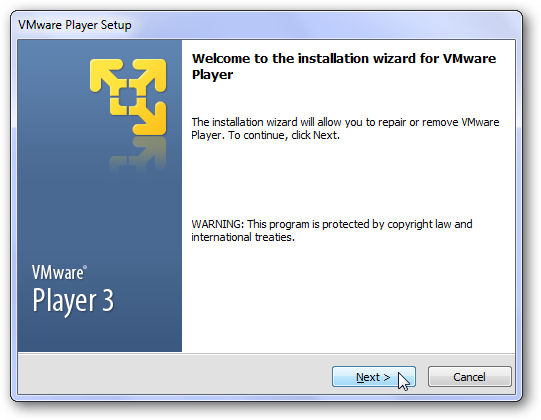
![sshot-2010-02-16-[19-14-34]](https://static1.howtogeekimages.com/wordpress/wp-content/uploads/2010/02/sshot20100216191434.png)
